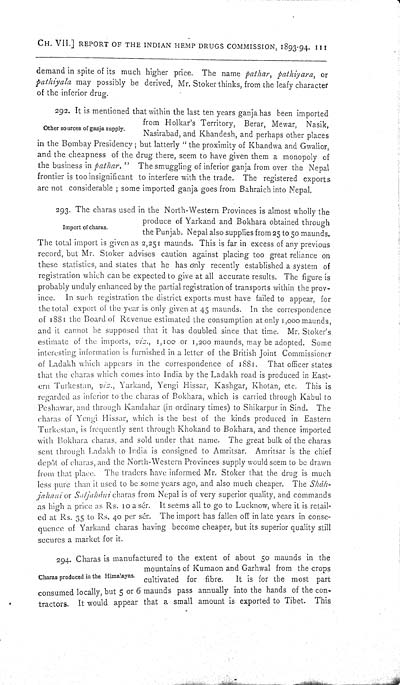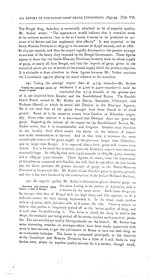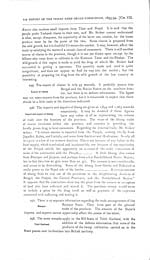Medicine - Drugs > Report of the Indian Hemp Drugs Commission, 1894-1895 > Volume I
(139) Page 111
Download files
Individual page:
Thumbnail gallery: Grid view | List view

CH. VII.] REPORT OF THE INDIAN HEMPP DRUGS COMMISSION, 1893-94. III
demand in spite of its
much higher price. The name pathar, pathiyara, or
pathiyala may possibly be derived, Mr. Stoker thinks, from
the leafy character
of the inferior drug.
Other sources of ganja supply.
292. It is mentioned that
within the last ten years ganja has been imported
from Holkar's Territory,
Berar, Mewar, Nasik,
Nasirabad, and Khandesh, and perhaps other places
in the Bombay Presidency;
but latterly "the proximity of Khandwa and Gwalior,
and the cheapness of the drug there, seem to have given them a
monopoly of
the business in pathar." The smuggling of inferior ganja
from over the Nepal
frontier is too insignificant to interfere with the trade. The
registered exports
are not considerable; some imported ganja goes from Bahraich into
Nepal.
Import of charas.
293. The charas used in
the North-Western Provinces is almost wholly the
produce of Yarkand and
Bokhara obtained through
the Punjab. Nepal also supplies from 25 to 50 maunds.
The total import is given as
2,251 maunds. This is far in excess of any previous
record, but Mr. Stoker advises caution against placing too great
reliance on
these statistics, and states that he has only recently established
a system of
registration which can be expected to give at all accurate results.
The figure is
probably unduly enhanced by the partial registration of transports
within the prov-
ince. In such registration the district exports must have failed to
appear, for
the total export of the year is only given at 45 maunds. In the
correspondence
of 1881 the Board of Revenue estimated the consumption at only
1,000 maunds,
and it cannot be supposed that it has doubled since that time. Mr.
Stoker's
estimate of the imports, viz., 1,100 or 1,200 maunds, may be
adopted. Some
interesting information is furnished in a letter of the British
Joint Commissioner
of Ladakh which appears in the correspondence of 1881. That officer
states
that the charas which comes into India by the Ladakh road is
produced in East-
ern Turkestan, viz., Yarkand, Yengi Hissar, Kashgar, Khotan,
etc. This is
regarded as inferior to the charas of Bokhara, which is carried
through Kabul to
Peshawar, and through Kandahar (in ordinary times) to Shikarpur in
Sind. The
charas of Yengi Hissar, which is the best of the kinds produced in
Eastern
Turkestan, is frequently sent through Khokand to Bokhara, and
thence imported
with Bokhara charas, and sold under that name. The great bulk of
the charas
sent through Ladakh to India is consigned to Amritsar. Amritsar is
the chief
depôt of charas, and the North-Western Provinces supply would seem
to be drawn
from that place. The traders have informed Mr. Stoker that the drug
is much
less pure than it used to be some years ago, and also much cheaper.
The Sháh-
jahani or Saljaháni charas from Nepal is of very superior
quality, and commands
as high a price as Rs. 10 a sér. It seems all to go to Lucknow,
where it is retail-
ed at Rs. 35 to Rs. 40 per sér. The import has fallen off in late
years in conse-
quence of Yarkand charas having become cheaper, but its superior
quality still
secures a market for it.
Charas produced in the Himalayas.
294. Charas is
manufactured to the extent of about 50 maunds in the
mountains of Kumaon and
Garhwal from the crops
cultivated for fibre. It is for the most part
consumed locally, but 5 or 6
maunds pass annually into the hands of the con-
tractors. It would appear that a small amount is exported to Tibet.
This
Set display mode to: Large image | Zoom image | Transcription
Images and transcriptions on this page, including medium image downloads, may be used under the Creative Commons Attribution 4.0 International Licence unless otherwise stated. ![]()
| India Papers > Medicine - Drugs > Report of the Indian Hemp Drugs Commission, 1894-1895 > Volume I > (139) Page 111 |
|---|
| Permanent URL | https://digital.nls.uk/74574344 |
|---|---|
| Description | Chapter VII, cont. |
| Description | [Volume 1]: Report. |
|---|---|
| Attribution and copyright: |
|




